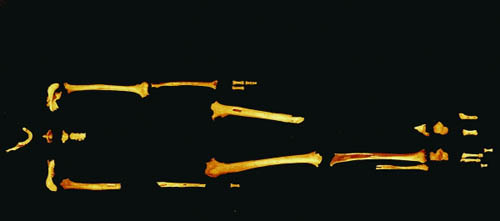| Location: Home > Research > Research Progress |
| DNA Analyses Show Early Modern Human 40000 Years Ago in Beijing Area Related to Present-Day Asians and Native Americans |
|
Scientists from the Institute of Vertebrate Paleontology and Paleoanthropology (IVPP), Chinese Academy of Sciences in Beijing, China, and the Max Planck Institute for Evolutionary Anthropology in Leipzig, Germany, extracted nuclear and mitochondrial DNA from a 40,000 years old leg bone found in 2003 at the Tianyuan Cave site located near Beijing. Analyses of this individual's DNA as reported online early edition January 21 in Proceedings of the National Academy of Sciences, showed that the Tianyuan human shared a common origin with the ancestors of many present-day Asians and Native Americans. In addition, the researchers found that the proportion of Neanderthal and Denisovan-DNA in this early modern human is not higher than in people living in this region nowadays.
The term “early modern humans” generally refers to humans who fall within the morphological variation of present-day humans and date to the Middle or Early Upper Paleolithic. The earliest modern humans appear in the Eurasian fossil record about 45,000 years ago, whereas the last remains that tend to be classified as early modern humans are about 25,000 years old. Their genetic relationship to present-day humans is unclear. Similarly, their relationship to archaic humans is of interest, given that they may have interacted directly with them. The Tianyuan specimen, a partial human skeleton, was unearthed with abundant late Pleistocene faunal remains in 2003 in the Tianyuan Cave near the Zhoukoudian site in northern China, about 50 km southwest of Beijing. The skeleton was radiocarbon-dated to 34,430 ± 510 years before present (BP) (uncalibrated), which corresponds to ~40,000 calendar years BP. A morphological analysis of the skeleton confirms initial assessments that this individual is a modern human, but suggests that it carries some archaic traits that could indicate gene flow from earlier hominin forms. The Tianyuan skeleton is thus one of a small number of early modern humans more than 30,000 years old discovered across Eurasia and an even smaller number known from East Asia. Using a highly scalable hybridization enrichment strategy, researchers determined the DNA sequences of the mitochondrial genome, the entire nonrepetitive portion of chromosome 21 (~30 Mbp), and over 3,000 polymorphic sites across the nuclear genome of this individual. The nuclear DNA sequences determined from this early modern human reveal that the Tianyuan individual derived from a population that was ancestral to many present-day Asians and Native Americans but postdated the divergence of Asians from Europeans. They also show that this individual carried proportions of DNA variants derived from archaic humans similar to present-day people in Asia. “That Europeans and East Asians had diverged by 40,000 years ago is consistent with dates for the first archaeological appearance of modern humans in Europe and also with the upper end of an estimate for the divergence of East Asian and European populations from nuclear DNA variation in present-day populations”, said coauthor GAO Xing of the IVPP. “In order to evaluate DNA preservation and the degree of modern human contamination in the Tianyuan skeleton, we prepared two DNA extracts from the left femur and two from the right tibia of the human skeleton excavated in Tianyuan Cave using less than 100 mg of bone material per extraction. Sequencing of random DNA fragments from DNA libraries constructed from these four extracts revealed that about 0.01–0.03% of the DNA in the libraries was of human origin”, said first author FU Qiaomei of the IVPP, “This low percentage of endogenous DNA precludes sequencing of the entire genome of this individual. However, we used DNA hybridization capture approaches to retrieve the mitochondrial DNA and nuclear DNA sequences successfully even when large quantities of DNA from soil bacteria are present. This opens the possibility of generating DNA sequences from previously inaccessible ancient samples.” “The Tianyuan individual lived during an important evolutionary transition when early modern humans, who shared certain features with earlier forms such as Neanderthals, were replacing Neanderthals and Denisovans, who later became extinct”, said Svante Pääbo, coauthor and project designer of the study, the Max Planck Institute for Evolutionary Anthropology, “More analyses of additional early modern humans across Eurasia will further refine our understanding of when and how modern humans spread across Europe and Asia”. This work was supported by the Chinese Academy of Sciences Strategic Priority Research Program, the Basic Research Data Projects of the Ministry of Science and Technology of China, and the Max Planck Society and its Presidential Innovation Fund.  Fig.1 The Tianyuan skeleton, unearthed with abundant late Pleistocene faunal remains in 2003 in the Tianyuan Cave near the Zhoukoudian site in northern China, about 50 km southwest of Beijing. (Image by GAO Xing) |